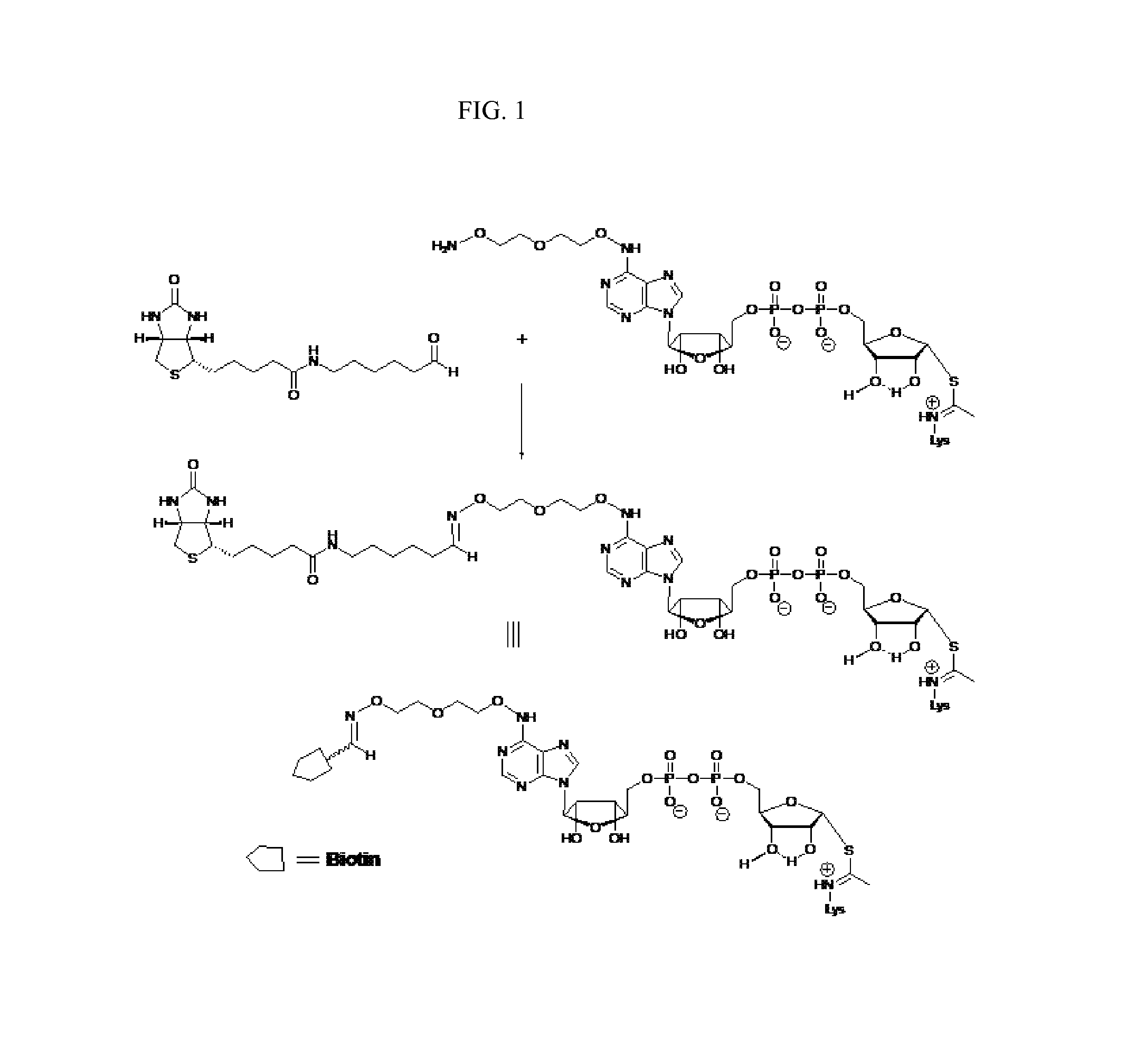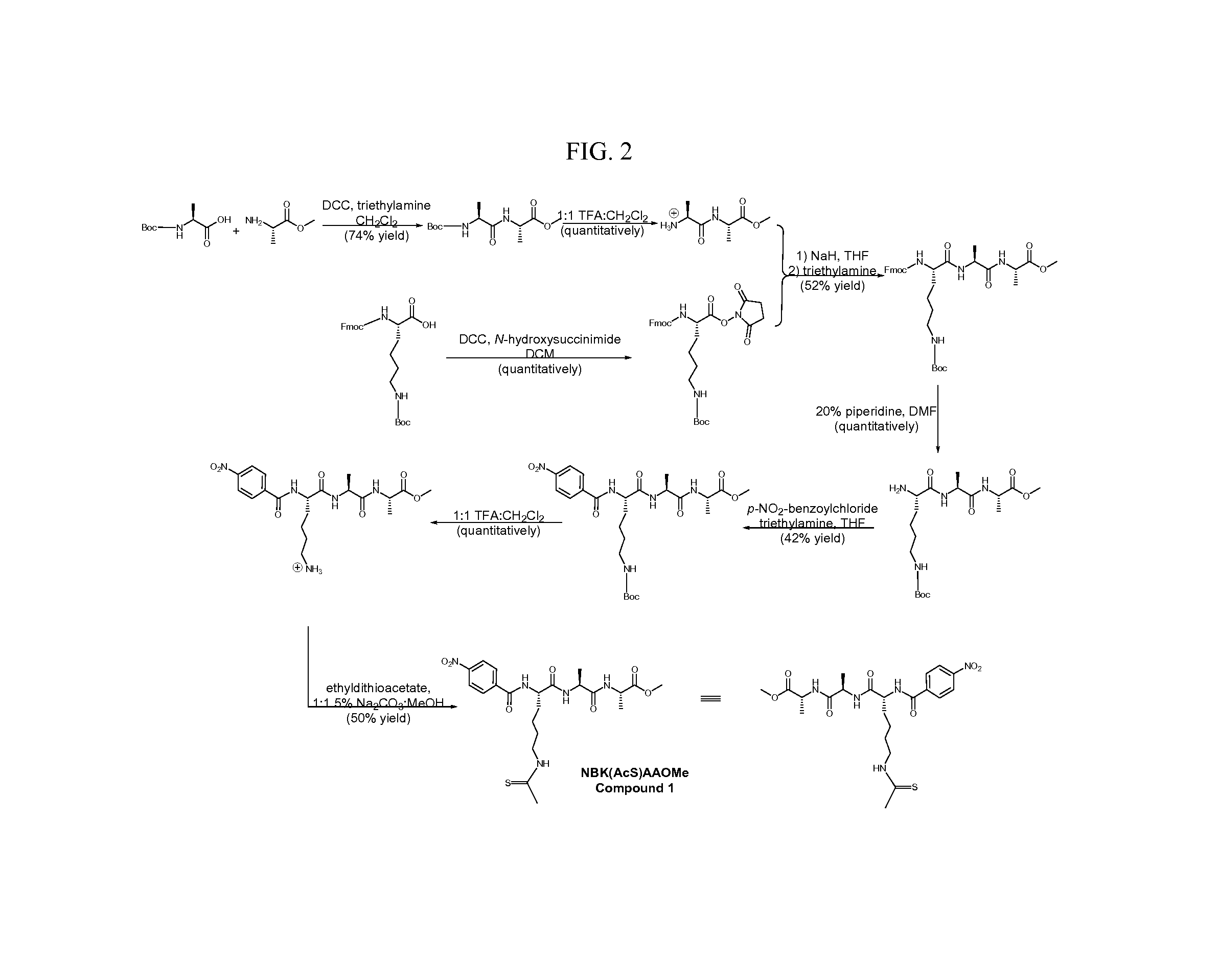Reagents and methods for sirtuin capture
a technology of sirtuin and reagents, applied in the field of reagents and methods for sirtuin capture, can solve the problems of many studies, such as transgenic models, and are limited to qualitative observations
- Summary
- Abstract
- Description
- Claims
- Application Information
AI Technical Summary
Benefits of technology
Problems solved by technology
Method used
Image
Examples
example 1
[0099]This example describes the expression and purification of sirtuin enzymes.
[0100]SirT1, SirT2, SirT3, SirT3(118-399), SirT4, SirT5(34-302) and SirT6. The sequences for SirT1, SirT2, SirT3, SirT3(118-399), SirT4, SirT5(34-302) and SirT6 were cloned into a pSTblue vector by blunt cloning and were subsequently cloned into a pET28a vector (Novagen) containing an N-terminal poly histidine tag. The sequence of the cloned genes was verified by nucleotide sequencing (Genewiz) and checked against the published sequence. The pET28a plasmid containing the sirtuin gene was then transfected into BL21-CodonPlus(DE3)-RIPL Competent cells (Stratagene) and each sirtuin expression was induced by IPTG when the cells were grown to OD600 of 0.6˜0.7 in LB media. The protein induction conditions were optimized for each sirtuin isoform. Specifically: SirT1 was induced with 100 μM IPTG overnight at room temperature; SirT2 was induced with 500 μM IPTG for 1 hour at 37° C.; SirT3(118-399) was induced wit...
example 2
[0102]This example demonstrates the synthesis of 6-chloropurine riboside 5′-phosphate.
[0103]6-Chloropurine riboside (100 mg, 0.35 mmol) was dissolved in 1.75 mL of trimethyl phosphate. Phosphoryl chloride (160 mg, 1.05 mmol) was dissolved in a mixture of 0.17 mL of trimethylphosphate and 6.3 μL of water. Both solutions were cooled to 0° C., mixed and stirred on a magnetic stirrer at 0° C. After 6 hours, ice was added to quench the reaction and the pH was adjusted to 7 by addition of ammonium hydroxide solution. The crude product was then concentrated and purified on a C18 reverse phase column using water as the mobile phase. The fractions containing desired product were combined and lyophilized to dryness to afford 6-chloropurine riboside 5′-phosphate (96 mg, 0.26 mmol, 75%) as a white solid. 1H NMR (D2O, 500 MHz) δ (ppm): 4.20 (m, 2H), 4.42 (m, 1H), 4.55 (t, J=4.6 Hz, 1H), 4.84 (m, 1H), 6.28 (d, J=5.1 Hz, 1H), 8.79 (s, 1H), 8.86 (s, 1H).
example 3
[0104]This example demonstrates the synthesis of N6-(O-[2-(2-aminooxy-ethoxy)-ethyl]-hydroxyamine)-AMP.
[0105]O-[2-(2-aminooxy-ethoxy)-ethyl]-hydroxyamine was prepared by the method described in Sadamoto et al., J. Am. Chem. Soc., 126: 3722-3761. A solution of 6-chloropurine riboside 5′-phosphate as described in Example 2 (15 mg, 0.041 mmol) in 0.34 mL of water was treated with a solution of O-[2-(2-aminooxy-ethoxy)-ethyl]-hydroxyamine (56 mg, 0.41 mmol) and triethylamine (14 mg, 0.14 mmol) in 0.33 mL of water at 25° C. and kept overnight. The reaction mixture was concentrated and purified on a C18 reverse phase column using water and methanol as the mobile phase. The desired product was eluted using 10% methanol-90% water as eluent. Appropriate fractions were combined and lyophilized to dryness to afford the title compound (8.6 mg, 0.018 mmol, 45%) as an off-white solid. 1H NMR (D2O, 500 MHz) δ (ppm): 3.90 (dt, J=4.2, 18.9 Hz, 4H), 4.14 (m, 2H), 4.28 (dt, J=4.1, 20.6 Hz, 4H), 4.42 (...
PUM
| Property | Measurement | Unit |
|---|---|---|
| molecular weight | aaaaa | aaaaa |
| flow rate | aaaaa | aaaaa |
| time | aaaaa | aaaaa |
Abstract
Description
Claims
Application Information
 Login to View More
Login to View More - Generate Ideas
- Intellectual Property
- Life Sciences
- Materials
- Tech Scout
- Unparalleled Data Quality
- Higher Quality Content
- 60% Fewer Hallucinations
Browse by: Latest US Patents, China's latest patents, Technical Efficacy Thesaurus, Application Domain, Technology Topic, Popular Technical Reports.
© 2025 PatSnap. All rights reserved.Legal|Privacy policy|Modern Slavery Act Transparency Statement|Sitemap|About US| Contact US: help@patsnap.com



